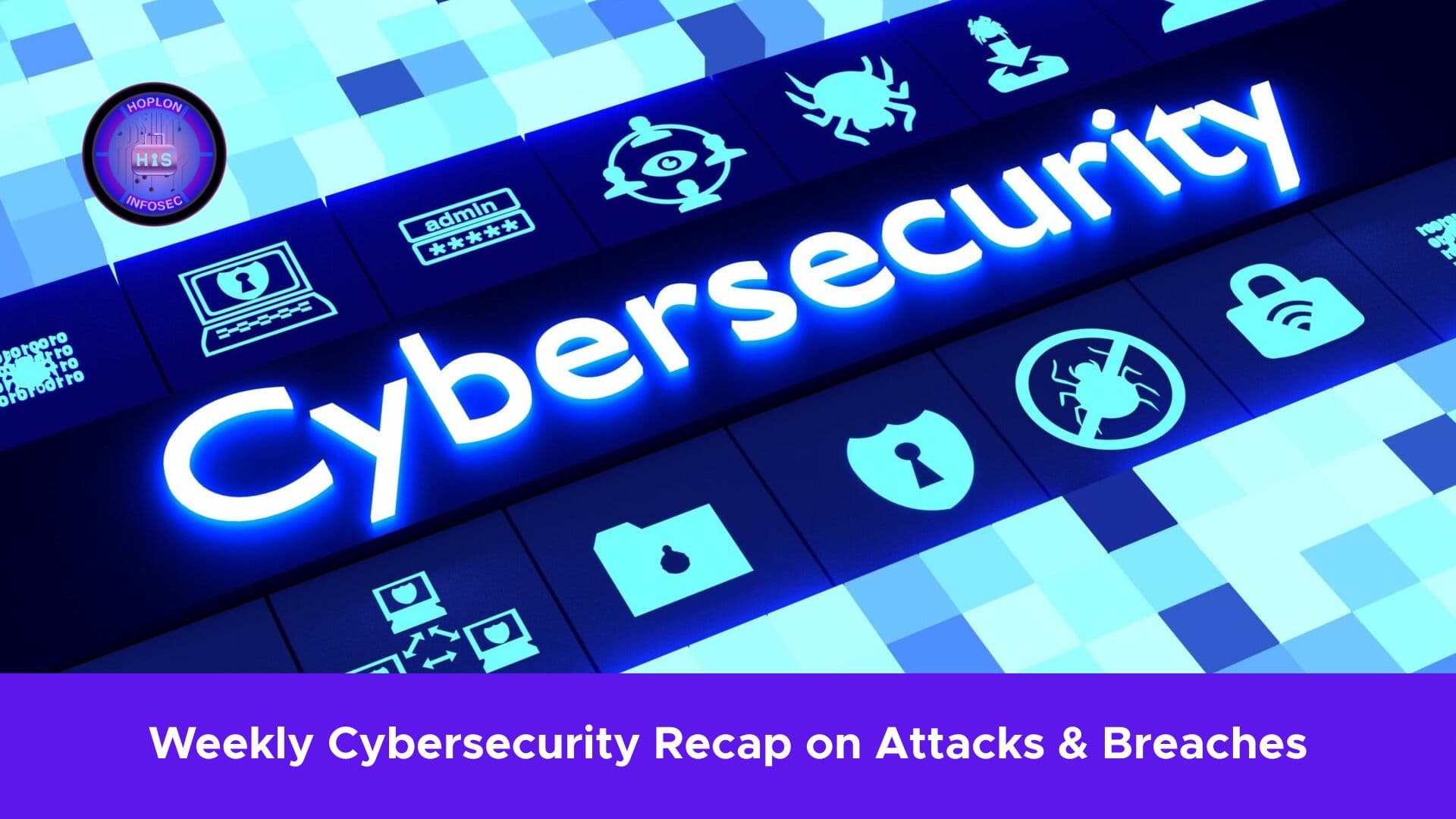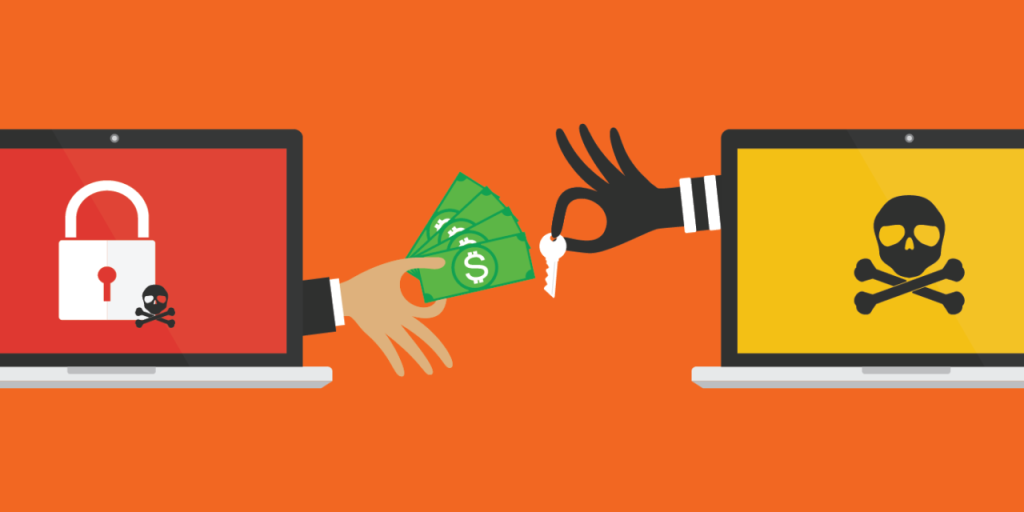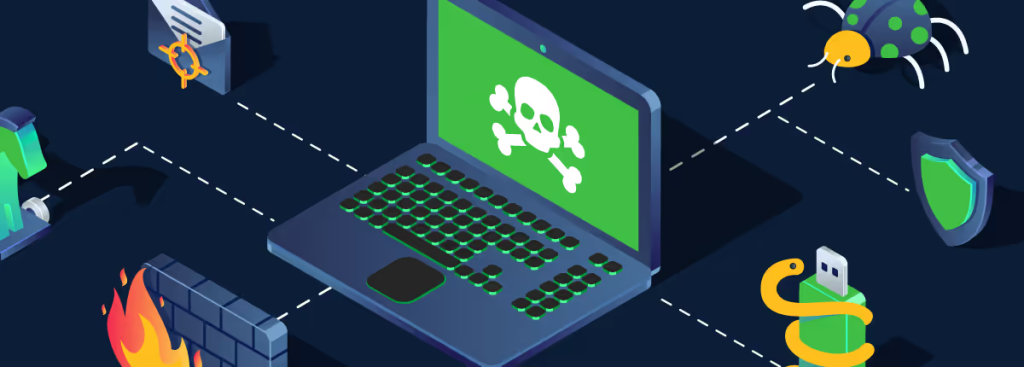Stay Informed: Weekly Cybersecurity Recap on Attacks & Breaches

Hoplon InfoSec
13 Apr, 2025
This newsletter aims to provide an in-depth look at emerging threats, evolving tactics employed by cybercriminals, and the cutting-edge technologies shaping our defences. In the coming sections, we will explore topics ranging from advanced ransomware schemes to vulnerabilities in widely used software platforms. With the proliferation of AI, machine learning, and quantum computing, both defenders and attackers are adapting rapidly, making it imperative for organizations to adopt proactive security measures.
Cybersecurity remains a cornerstone of modern business operations. Organizations of all sizes grapple with increasingly sophisticated attacks that exploit vulnerabilities in legacy systems and emerging technologies. This edition is designed to offer a comprehensive understanding of these issues, providing actionable insights and highlighting recent developments that every security professional should know.
Emerging Threats and Evolving Tactics
Attackers innovate as cyber threats become more advanced, leveraging new technologies and techniques to breach defences. Below, we delve into several key areas where adversaries have recently made significant strides.
Advanced Ransomware and Targeted Attacks

Ransomware attacks have evolved far beyond simple data encryption. Modern ransomware, such as CatB, now employs sophisticated methods like DLL hijacking via the Microsoft Distributed Transaction Coordinator (MSDTC). This tactic not only facilitates the execution of malicious payloads but also helps the malware evade detection by using techniques that can bypass virtual machine monitors. Such attacks are frequently linked to state-sponsored groups like ChamelGang, emphasizing the need for continuous monitoring and rapid response strategies.
Organizations are now advised to implement robust incident response plans that include regular backups, network segmentation, and comprehensive employee training. These measures, alongside real-time threat intelligence, are vital in mitigating the risks of ransomware attacks and limiting potential downtime.
The Rising Influence of State-Sponsored Cyber Activities
State-sponsored cyber activities have significantly shifted the landscape of global security. These campaigns often target government agencies and critical infrastructure using sophisticated social engineering and malware techniques. In recent months, campaigns attributed to state actors have exploited vulnerabilities in remote desktop protocols (RDP) and other enterprise systems. Such operations compromise data integrity and threaten national security by undermining public trust in digital infrastructures.
In response, governments and private sector organizations are intensifying efforts to fortify their cyber defences. Collaborative initiatives between law enforcement and cybersecurity firms have improved intelligence sharing, enabling quicker responses to emerging threats.
The Impact of Advanced Technologies

The rapid advancement of technologies like artificial intelligence (AI), machine learning (ML), and quantum computing is a double-edged sword in cybersecurity. While these tools offer significant benefits for detecting and mitigating threats, they also present new avenues for attackers to exploit.
AI-Powered Phishing Schemes
Phishing remains one of the most prevalent cyber threats, and the integration of AI has made these schemes more convincing and more challenging to detect. Cybercriminals now employ AI to generate highly personalized phishing messages, which can deceive even the most cautious users. This evolution underscores the importance of continuous user education and advanced filtering systems to identify and block malicious emails before they reach inboxes.
Machine Learning-Enhanced Malware
Machine learning is being used by both defenders and attackers in the cybersecurity arena. On the defensive side, ML algorithms help in anomaly detection and predictive threat analysis, enabling faster identification of unusual network behaviour. Conversely, attackers have started using ML to craft malware that can adapt to security measures and evade traditional detection techniques. This tug-of-war between attackers and defenders is pushing the boundaries of cybersecurity innovation.
Quantum Computing and Encryption Vulnerabilities
Quantum computing holds the promise of revolutionizing many industries, including cybersecurity. However, its potential to break current encryption standards poses a significant risk. As quantum computing technology advances, cybersecurity experts are urgently working on integrating post-quantum cryptography algorithms to safeguard data against future threats. The introduction of OpenSSL 3.5.0, for example, includes algorithms designed to resist quantum attacks, marking an essential step in the evolution of cryptographic security.
Detailed Analysis of Recent Cyber Attacks

This section provides an in-depth look at several recent cyber attacks that have recently made headlines. Each incident highlights different methods attackers use and offers lessons on how organizations can bolster their defences.
Attackers Exploiting Software Distribution Platforms
One emerging trend is the exploitation of reputable software hosting platforms like SourceForge. Cybercriminals have been distributing malware disguised as legitimate Microsoft Office applications. These attacks often use deceptive domain names and password-protected archives to bypass standard security checks. The final payload typically includes cryptocurrency miners and Trojans that intercept and manipulate cryptocurrency transactions. This incident serves as a reminder to scrutinize software downloads and validate sources before installation.
Vulnerabilities in E-Commerce and Web Management Tools
Software vulnerabilities continue to be a primary target for attackers. For instance, a recent Shopware Security Plugin (version 2.0.10) flaw exposed many older installations to SQL injection attacks. Such vulnerabilities can allow attackers to extract sensitive data from compromised systems. Shopware has since released patches to address the issue, highlighting the need for regular software updates and vulnerability management practices. Organizations should ensure that all plugins and third-party tools are updated as soon as new patches are available.
Sophisticated Email-Based Attacks
Phishing remains a dominant threat vector, with attackers constantly refining their techniques. A recent sophisticated email attack targeting Office365 credentials demonstrates the multi-faceted nature of these campaigns. In this case, emails containing malicious attachments were used to deliver malware, including the ConnectWise RAT, which facilitates remote access to compromised systems. This attack underlines the need for robust email security solutions to detect and quarantine suspicious messages before they reach end users.
Exploitation of Remote Desktop Protocol (RDP) Vulnerabilities
Ransomware attackers have increasingly focused on domain controllers (DCs) by exploiting Remote Desktop Protocol (RDP) vulnerabilities. By gaining unauthorized access through RDP, attackers can move laterally across networks and eventually encrypt critical systems. Microsoft Defender and other endpoint security solutions have effectively contained such attacks. Still, organizations must also enforce strict access controls and monitor RDP activity closely to prevent unauthorized access.
The Role of Spam Frameworks in Cybercrime
The AkiraBot spam framework, a Python-based tool, has been reported to target tens of thousands of websites by bypassing CAPTCHA protections. This bot framework generates personalized messages using AI techniques to facilitate SEO scams and fraudulent activities. Following widespread reports of abuse, service providers like OpenAI have taken steps to turn off the associated API keys. This incident emphasizes the importance of robust spam filters and continuous web traffic monitoring for signs of automated abuse.
Mobile Application Malware and Data Theft
Mobile applications continue to be a fertile ground for cybercriminals. A prime example is the fake mParivahan app, which was distributed via WhatsApp messages to deceive Android users. This malicious application was designed to steal sensitive data, including SMS and social media credentials, by employing advanced anti-analysis techniques. Users are advised to download applications only from official app stores and to exercise caution when receiving unsolicited links or messages.
In-Depth Look at Cyber Threat Campaigns

Beyond individual attacks, several organized threat groups are engaging in coordinated campaigns that target specific sectors or exploit particular vulnerabilities.
Exploitation of Windows RDP Files by State Actors
A notable espionage campaign, reportedly driven by Russian state actors, has been exploiting Windows RDP files. By sending phishing emails containing malicious . With RDP file attachments, attackers can infiltrate European government and military systems. This method allows them to surreptitiously access file systems and clipboard data, thereby stealing sensitive information without immediate detection. The sophistication of this campaign underscores the importance of enhanced security protocols for government and critical infrastructure sectors.
Supply Chain Attacks on Cryptocurrency Developers
The cryptocurrency ecosystem has not been immune to cyber threats. Recently, two malicious Python packages on the Python Package Index (PyPI) were found to be harvesting sensitive crypto wallet data. These packages were disguised as updates for the BitcoinLib library, exemplifying a growing trend in supply chain attacks. Such attacks target not only end users but also the developers who build upon open-source libraries. The incident highlights the critical need for rigorous code review processes and enhanced security measures for software distribution channels.
Evolving Ransomware Strategies
The ransomware landscape constantly evolves, with groups like Hellcat updating their tactics to target a broader range of sectors, including government, education, and energy. These groups can enforce double extortion strategies by exploiting zero-day vulnerabilities and employing reflective code-loading techniques. This forces victims to pay ransom to recover encrypted data and threatens to leak stolen information if demands are unmet. Organizations are encouraged to invest in comprehensive backup solutions and to conduct regular security audits to identify potential vulnerabilities before they can be exploited.
Social Engineering and the Use of Python Scripts
State-sponsored groups from North Korea have been observed employing a combination of social engineering tactics and Python scripts to breach secure networks. These campaigns often involve using obfuscated code to hide malicious commands, making it challenging for traditional security measures to detect the threat. The attackers’ reliance on open-source scripting languages further complicates the security landscape, as these tools can be easily modified and redistributed. Continuous monitoring and advanced behavioural analytics are essential to counter these sophisticated attacks.
Phishing Attacks on Multi-Factor Authentication (MFA) Systems
Another emerging threat is the targeting of Multi-Factor Authentication (MFA) systems. Cybercriminal groups like Scattered Spider have refined their phishing techniques to capture login credentials and MFA tokens. By compromising authentication portals such as Okta, these attackers can bypass additional layers of security and gain persistent access to victim networks. Organizations must enhance their MFA protocols, including implementing adaptive authentication measures and educating users about the latest phishing trends.
Impersonation and Credential Harvesting by Advanced Persistent Threats
Groups like SideCopy, which are linked to state-sponsored activities, are known for their sophisticated spear-phishing campaigns. These attacks often involve creating fake domains that closely mimic official government websites, tricking users into disclosing sensitive credentials. Once credentials are harvested, the attackers leverage open-source tools such as XenoRAT to gain remote access. Adopting advanced domain monitoring tools and conducting regular cybersecurity drills for public sector organizations can help mitigate the risk of such impersonation attacks.
Malware Targeting Critical Infrastructure
Critical infrastructure, including energy companies, is constantly threatened by malware variants like Amethyst stealer, deployed by groups such as Sapphire Werewolf. This malware is specifically designed to extract credentials while employing techniques to detect and bypass virtual machine environments. The persistence of these threats requires organizations in critical sectors to invest in advanced threat detection systems and regularly update their security protocols to address new vulnerabilities.
Addressing Software Vulnerabilities and Regulatory Developments

Maintaining secure systems is not just about countering active threats—it also involves addressing vulnerabilities in widely used software and staying compliant with regulatory requirements.
Software Vulnerability Management
Recent patches and updates highlight the ongoing battle between software developers and cybercriminals. Google’s recent fix in Chrome addresses a 23-year-old vulnerability in the CSS: visited selector, which previously allowed websites to access a user’s browsing history through cross-site data leakage. By implementing “visited link partitioning,” Google has taken a significant step toward bolstering user privacy and security. This is an excellent example of how even long-standing issues can be resolved through persistent innovation and attention to detail.
Similarly, vulnerabilities have been identified in other popular platforms, such as WhatsApp Desktop for Windows. A spoofing vulnerability, CVE-2025-30401, enables attackers to execute malicious code through file attachments by exploiting discrepancies between MIME types and file extensions. Prompt updates to version 2.2450.6 or later safeguard users against such threats.
Another noteworthy example is the critical flaw discovered in the Nissan Leaf’s infotainment system, which allowed remote control of vehicle functions. This vulnerability, stemming from Bluetooth weaknesses and CAN Bus manipulation, highlights the expanding attack surface in connected devices. With over-the-air updates and dealership patches scheduled, this incident underscores the need for the automotive industry to prioritize cybersecurity in their product development cycles.
In addition, several vulnerabilities in enterprise-level solutions such as VMware and SonicWall have prompted urgent patches. VMware’s updates address multiple critical vulnerabilities across its Tanzu Greenplum products. At the same time, SonicWall has released patches for its NetExtender VPN client to mitigate risks of privilege escalation and file manipulation attacks. These incidents remind IT administrators to monitor and update all software components within their networks consistently.
Regulatory Developments and Data Privacy
Beyond technical vulnerabilities, regulatory frameworks are playing an increasingly critical role in shaping cybersecurity practices. Regulatory measures such as the European Union’s General Data Protection Regulation (GDPR) and California’s Consumer Privacy Act (CCPA) set stringent data privacy and security standards. These regulations require organizations to implement robust data protection strategies and to be transparent about their data handling practices.
Recent developments in data breach disclosures further illustrate the impact of these regulations. For example, Oracle recently confirmed a breach in its legacy systems, where threat actors exploited stolen credentials from previous years. The breach compromised client data and led to significant reputational damage and regulatory scrutiny. Similarly, the data breach experienced by WK Kellogg Co. involved sensitive employee information being accessed via third-party vendor software. These incidents underline the importance of comprehensive security protocols that extend beyond internal systems to encompass third-party vendors and legacy infrastructure.
The Future of Cybersecurity: Innovations and Collaborative Efforts
The cybersecurity landscape is evolving, and the future promises even more challenges and opportunities. One key area of innovation is the integration of artificial intelligence and machine learning into security operations. As discussed earlier, these technologies empower attackers and provide defenders with powerful tools to predict and neutralize threats.
Emerging Recon Tools and AI-Driven Security
Innovative tools like Subwiz, an AI-powered recon tool, are set to revolutionize how security professionals discover hidden subdomains. By leveraging machine learning algorithms, Subwiz offers a more efficient and accurate alternative to traditional brute-force methods. It found significantly more subdomains during benchmarking tests, providing a clearer picture of an organization’s digital footprint. Tools like these are invaluable for ethical hackers and cybersecurity teams seeking to identify potential attack vectors preemptively.
OpenSSH and IPFire Enhancements
In parallel, updates to critical infrastructure tools such as OpenSSH and IPFire reinforce the defences of secure shell environments and VPN tunnels. OpenSSH version 10.0 has introduced new cryptographic algorithms and performance optimizations, ensuring that secure connections remain resilient despite emerging threats. Likewise, the latest version of IPFire, 2.29, includes support for post-quantum cryptography, providing forward-looking protection against the evolving capabilities of quantum computers. Such innovations are critical for maintaining robust security in a rapidly changing technological landscape.
Collaborative Efforts Against Cybercrime
In addition to technological advancements, international law enforcement agencies and cybersecurity professionals are intensifying collaborative efforts. Operations such as the recent crackdown on Smokeloader malware operators have demonstrated the effectiveness of coordinated actions that target the malware and the criminal networks that support it. By arresting individuals distributing and monetizing malware, authorities are sending a strong message that cybercrime will not be tolerated. These efforts and continuous information sharing among industry stakeholders are essential in building a resilient global cybersecurity posture.
Best Practices for Enhancing Cybersecurity

Given the complexity and scale of modern cyber threats, organizations must adopt a multi-layered approach to security. The following best practices can serve as a guide for businesses seeking to enhance their cybersecurity posture:
Proactive Threat Intelligence and Monitoring
Investing in proactive threat intelligence systems is essential. Organizations should continuously monitor for unusual activity and implement real-time analytics to detect potential breaches before they escalate. Regular vulnerability assessments and penetration testing are key components of a robust cybersecurity strategy.
Regular Software Updates and Patch Management
Timely patching of software vulnerabilities is critical in minimizing the attack surface. Whether it’s a long-standing browser flaw or a newly discovered vulnerability in a crucial application, keeping systems up-to-date is one of the most effective ways to prevent exploitation.
Comprehensive Employee Training
Since human error often plays a significant role in security breaches, regular employee training sessions are indispensable. Educating staff on recognizing phishing attempts, safe internet practices, and the importance of multi-factor authentication can significantly reduce the risk of successful cyber attacks.
Enhanced Network Segmentation and Access Controls
Implementing network segmentation and strict access controls can help contain breaches and limit lateral movement within an organization’s network. By compartmentalizing systems, organizations can isolate compromised sections and prevent widespread damage.
Incident Response Planning
Developing and regularly updating an incident response plan is a best practice every organization should follow. This plan should include clear procedures for identifying, containing, and recovering from security incidents and communication protocols for internal and external stakeholders.
Concluding Thoughts
As cyber threats continue to evolve in sophistication and scale, staying informed and prepared is more critical than ever. This newsletter has highlighted some of the most pressing challenges facing cybersecurity professionals today—from advanced ransomware attacks and state-sponsored espionage to vulnerabilities in everyday applications and the emerging role of quantum computing. Each topic discussed emphasizes the importance of proactive defence, continuous monitoring, and collaborative efforts in creating a secure digital environment.
The future of cybersecurity lies in balancing technological innovation with vigilant, ongoing efforts to identify and mitigate risks. By investing in advanced security tools, adopting comprehensive best practices, and fostering an organizational culture of awareness and preparedness, businesses can navigate the complexities of modern cyber threats and safeguard their critical assets.
In an era where the digital landscape is as dynamic as it is essential to our daily lives, the insights provided in this newsletter remind us that cybersecurity is a shared responsibility. Whether you are a seasoned professional or a small business owner, staying informed and proactive is your best defence against the evolving challenges of the digital age.
We hope this detailed overview has given you a deeper understanding of the cybersecurity environment and practical guidance on bolstering your defences. Stay tuned for future editions as we explore emerging threats, breakthrough technologies, and best practices that will help you stay one step ahead in cybersecurity.
Sources: The Hacker News
Share this :